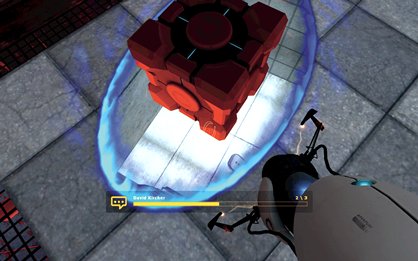See through the specs
Minimum system requirements often mean minimum fun. Is the industry honest about what hardware games need?
Why would a games developer, after slaving for years to realise an artistic vision, agree that someone should be encouraged to play their game at low resolution, with all graphical effects turned off, and still be subject to bouts of slowdown? It’s true that graphics do not a good game make, but what if you’ve had to reduce things so far you’re not even playing the game the developer designed anymore? Our insider told us this was a common cause of frustration at software houses: that gamers are buying their games, but only playing a rough approximation of them.
“Arriving at the minimum spec is a collaboration of business needs, technology constraints and game design,” our Deep Throat told us. “If all three things aren’t accounted for, it is highly unlikely that a meaningful minimum spec can be attained.

Above: "I bring you love at 16 fps"
The goal is always to make the most compelling game that will play on the largest number of installed computers. There are always exceptions. Some developers want to differentiate themselves with technological features and graphic fidelity. In those cases (whether they know it or not) they’re shooting for fame rather than sales. They hope that the press and hardware manufacturers will build a lot of hype for their game, thus boosting the perceived success of their game. The emphasis here is on the word ‘perceived’. You can have the best engine ever, but if the minimum spec is too high, you won’t sell many copies and may go out of business.”
Most of the major technical demands for a game will have been decided at the start of the development process. There’s an early dialogue in all games design that determines whether, for example, a DirectX 7.0 fallback path will be incorporated for older hardware, or if the game loop is going to be multithreaded. Devs have an eye on the kind of system they imagine to be entry level for their game, and we’d take an educated guess that it’s rarely the one that ends up on the back of the box.
Valve, for example, are led by their intricate knowledge of your machine thanks to the Steam survey. When only a few people were left with DirectX 7.0 video cards, the designers were told they could up their aspirations and begin writing DirectX 8-only games. Often, though, hitting goals for minimum specifications is put off until the last moment. “Publishers and developers often panic near the end of a game’s development,” our mole claims. “That’s a time when the spell of ‘make it shiny’ starts to wear off, and everyone is reminded that gameplay is what makes the game truly fun... and that gameplay isn’t fun at 5 frames per second. That’s the time you start ripping out all the shiny features you put in earlier, or you wind up making them optional.”
The best piece of advice we can give is to ignore minimum specs on a game box altogether. In the current era of high quality visuals, it’s going to be an unusual game that plays acceptably on a PC that just scrapes through on the hardware requirements. Better to hold off until you can afford an upgrade that puts you closer to the ‘recommended’ spec.
Weekly digests, tales from the communities you love, and more

“If we want to reach more customers,” says one expert, “there should be NO nomenclature used to address the min spec question. The answer should be a simple yes/no. This is what the console customers experience, and I think the simplicity of it is a big part of the appeal of the consoles.”
We can’t do that, but we can help cut through all the confusion of which graphics card is capable of what and whether or not you need to upgrade your PC with a new ranking system: the hardware thermometer. The guide on the next page provides easy reference.


